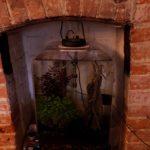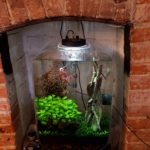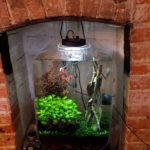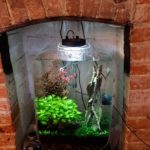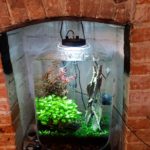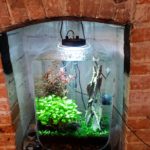Advantages of a programmable aquarium lighting controller
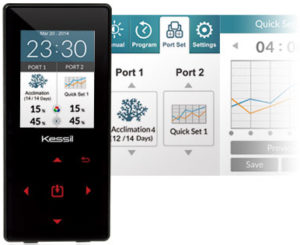
With the Kessil A80 LED, or most other aquarium lights, you don’t actually need a programmable controller, however, without a controller your options are to hand adjust light and colour twice a day, or more practically, to manually set the light and colour and then plug the light into a standard mains timer for control over “on” and “off” periods. The timer method works just fine, and I used that for about 6 months, but has some potential limitations…
- The light can only be either “on” or “off” and the transitions between the two states are abrupt. Do the abrupt transitions negatively affect the fish? My guess is no, however, some of the fish have very different behaviors when the light is on vs. when the light is off so you only ever get those two types of behaviors with the on/off method.
- To limit the growth of algae, the duration of bright intensity lighting has to be limited – I use 6 hours per day. That means the rest of the time, the tank is of necessity “dark”. With a controller you can programme extended periods of dim lighting in addition to the intense lighting period which lets you see the tank lit up for longer – hopefully the algae doesn’t grow during the dim lighting period!
- Being limited to controlling intensity and colour with the analog dials on top of the light means if you change either of those settings it’s hard to get things set back to exactly where they were before you messed with them.
Kessil A-series controller vs. Controller X
Kessil makes two types of programmable controller for their LED lights, the older A-series controller which I have, and the newer Spectral Controller X. The A-series has two independent 0-10V outputs to let you control two separate lights, while the Controller X has one 0-10V output to retain backwards compatibility, and one “K-link” modifed USB output that can control up to 32 separate lights, so long as those lights also have K-link inputs. The Kessil A80 light I have only takes a 0-10V input and can’t use K-link.
Programming the controller
Intensities and colours of the Kessil A80 LED using the A-series spectral controller
The A-series lets you specify both light and colour levels at 6 different programmable times of your choice throughout the day. The latest firmware version is v1.04, last updated in 2015, and I suspect there will be no further firmware updates to the A-series. Intensity and colour can be set independently to any of 21 different values – from 0% through 100% in increments of 5%. Time can be set to the nearest minute, except that immediately adjacent time settings must be at least 5′ apart (the firmware enforces this by shifting timepoints if you try to set them closer). The controller will automatically smoothly ramp up or down interpolating both intensity and colour between timepoints. The ramping displays in increments of single percent, but the functional output is always rounded up to the nearest 5% (to match the possible settable values) so for example 1%, 2%, 3%, 4% and 5% are all functionally identical to 5%. It is not possible to dim the light below the 5% level other than by having it turned off. According to Kessil technical support (which I have found to be very responsive), this 5% granularity is an inherent aspect of the 0-10V control of the A80 – connecting an A80 to the 0-10V output of the X-series controller would be no different in this regard. Switching to an X-series controller would give 8 settable timepoints rather than the 6 with the A-series.
Turn down the intensity on the Kessil LED light
Kessil per their stated policy never lists PAR values for their lights so you don’t know how bright they really are. After upgrading from the previous Oase MCR 2W LED to the Kessil 15W LED it seemed like a good idea to run the Kessil at full intensity, however, lately I’ve come around to thinking that’s too much light – just because the light can be crazy bright doesn’t mean it should be. Excessive light isn’t helpful to plants (and can actually be harmful) and promotes algae growth. I’ve now backed off the max intensity from 100% to 70%. The less bright light may also be less stressful for the fish. It could be a different story though for either a deeper tank, or a setup that uses floating plants which shade the rest of the aquarium – with a controller it’s easy to try different lighting scenarios.
Ramping subtleties – “it’s not a bug, it’s a feature!”
There are some counterintuitive aspects to the ramping with the A-series described below. These will be a function of the firmware so in theory this behaviour could be changed, some might say ‘fixed’ by Kessil if they were of a mind to do that.
Ramping down to zero
I have one timepoint set to 5% intensity with an adjacent timepoint set to 0% intensity (turn the light off) 60 minutes later. The controller interpolates the 5 steps down to zero (4, 3, 2, 1, 0) as each taking place over 60 / 5 = 12 minutes. The instant the ramp begins, the intesity goes from 5% to 4% – recall from the discussion above that functionally there is no difference between these two values so no visible change in the light intensity and the same is true with no visible lighting change as the controller goes to 3% after 12′, 2% after 24′, 1% after 36′, 0% after 48′ (at which point the light turns off) and then finally 0% (still) at the 60′ mark. This means the light turns off sooner than you might expect. If you want the light to actually turn off after 60′, you have to account for the interpolated stepping, so again going from 5% to turned off, set the turn off point to be 75′ later, not 60′. Then the light steps down to 4% immediately, 3% at 15′, 2% at 30′, 1% at 45′, 0% (turns off) at 60′, 0% (still) at the specified 75′ timepoint.
Ramping up from zero
Turning on in the morning I have the light transition from turned off to come on at the lowest intensity setting of 5% and stay at that level for one hour. Unlike the ramp down from 5% to 0 which goes in evenly spaced timing steps, with the light turned off overnight and the first timepoint of the new day set to 5% the light stays off the whole night, but then ramps up from 0 to 5% over the last 10′. So if the light is set to turn on with 5% intensity at 9:00, at 8:52 the light goes to 1%, which is to say functionally turns on as if set to 5%, then 2% at 8:54, 3% at 8:56, 4% at 8:58 and finally 5% at the set time of 9:00. If you want the light to actually turn on at 9:00 sharp, you have to set that first timepoint to 9:08 to get there.
